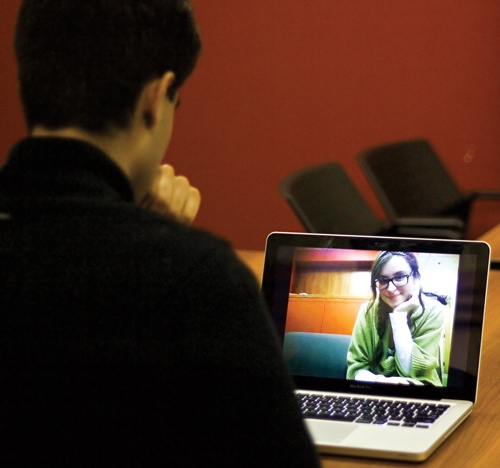Whether through OkCupid or Lavalife, people are heading online to find romantic partners
Staff Writer

When it comes to finding love, Dr. Jennifer Gibbs prefers the unconventional route. Instead of the typical awkward dinner date, or meeting at bars and parks, Gibbs prefers the internet.
A professor of communication specializing in self-representation, identity management, and online relationship formation, Gibbs is one of the thousands of people who went online to find her match. It paid off. Gibbs, now
26 and married, uses her experience to explain the surge in popularity towards online dating.
“When online dating sites first started there was definitely a stigma around doing it, and my husband and I had [a story] that
we would tell people. We told them we met at a café, because technically that was where our
first date was, when actually we met online.”
Since then however, Gibbs has noted that the public is far more receptive to dating websites.
“It’s definitely becoming mainstream. I think that a lot of younger people are doing it, so even though statistically there are more older people, I think it is becoming more popular with younger people as well.” By “young,” Gibbs is talking about the 20 to 30 age range, keeping in mind that the middle-aged demographic still appears to be the most prominent.
Based on statistics found in Gibbs’ research, one in five relationships now starts online, and five per cent of all marriages in the US start on an eHarmony connection.
There are many reasons that explain the rise in popularity of online dating. According to Gibbs, the younger generation begin to turn to websites because they are so busy pursuing professional careers that sometimes dating and meeting people are pushed to the bottom of their priorities list.
In the workforce “you don’t really have a pool of your peers and it gets harder to meet people to date,” she says. It’s also realistic for people not to want to date colleagues, keeping their romantic lives and professional lives separate.
Recent advancements in new media technologies are also a major contributor to the change in mentality towards online dating.
“Technology is becoming so much more incorporated into our lives, now we have social media like Facebook and Twitter and people are using the internet for very social purposes.”
Gibbs goes on to say that since people maintain friendships and other types of relationships online, “it makes sense that they would look to the internet for dating as well.”
Even if people are not using online dating sites specifically, many people are meeting online in other ways via channels like Facebook, or conversing with others via Skype or instant messaging.
If the lack of immediate relationship options is not enough to make the case for online dating, technology now offers undeniable convenience and efficiency.
By signing up on a dating site, there are thousands of profiles to browse from, and everybody there is looking for a relationship.
The design of these websites makes it possible to set filters when browsing through profiles. You might set an age filter to limit searches to people aged 25 to 35. This allows people to hone in on those who possess the specific qualities they are looking for, finding only the most compatible people in their search.
Dating websites can also reveal many important things such as “their interests, their hobbies, their religious beliefs and political views, whether they want children, smoking and drinking habits,” she says.
On these profiles, “you can find a lot of intimate information that you probably wouldn’t disclose on a first date.” In a lot of ways, this saves people time when it comes choosing the right partner.
Online dating allows people to easily find potential partners based on commonalities and individual-specific characteristics. They offer a large population of profiles to choose from. The online medium allows easy accessibility and convenience in using it as a tool.
But before anyone signs up for online dating, Gibbs makes sure to say that not everything you see online is what you get. The biggest problem, Gibbs found in her research, is misrepresentation.
Misrepresentation is concerned with things such as photo inaccuracy, or misleading information on profiles (lying about age is not uncommon). Many people are worried about the question, “Are you who you say you are?”
This is a pressing issue, because Gibbs says people “tend to present an ideal self in online dating.” People have the time to carefully craft their profile and create an image of themselves that they find desirable, one that is sometimes distorted and untrue to their real character.
Gibbs calls this “selective self-presentation,” because people can choose what others see and don’t see on their profile. She also found in her research that men and women, although both equally guilty of misrepresentation, tend to do so in different ways.
Men are more likely to misrepresent marital status, relationship goals, annual income, and education. Women on the other hand are more likely to misrepresent their photos and physical appearance.
Nowadays, it’s fairly easy to find someone who goes online to date, or find a married couple who met on a website. And though there are some precautions to take with online dating, it may just be the option that’s right for you.



